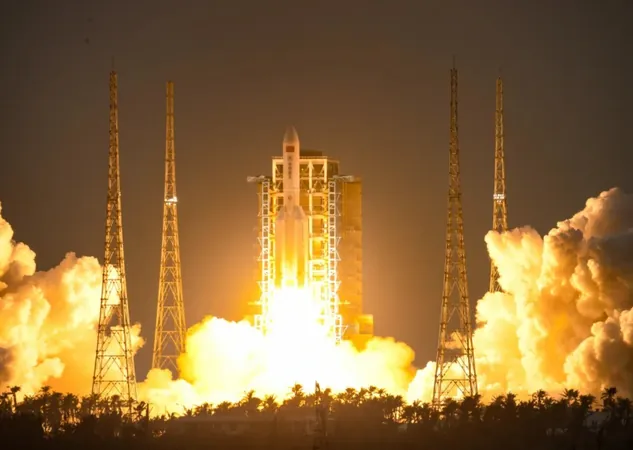
China Unveils Ambitious Guowang Megaconstellation with Successful Long March 5B Launch
2024-12-16
Author: Wei
Introduction
In a significant milestone for its space ambitions, China launched the first batch of satellites for its Guowang megaconstellation from Hainan Island early Monday. The Long March 5B rocket, equipped with a Yuanzheng-2 upper stage, blasted off from the Wenchang Satellite Launch Center at 5:00 a.m. Eastern Time (10:00 UTC) on December 16, marking the inception of the Guowang project, which translates to “national net.”
Launch Details
While official announcements were scarce, live streams from amateur observers captured the excitement as large crowds gathered on nearby beaches to witness the historic event. Approximately two hours post-launch, the Shanghai Academy of Spaceflight Technology (SAST) confirmed that the rocket successfully sent its payload into orbit. However, details regarding the specific number of satellites and their orbits remain undisclosed.
Global Communication Initiative
The satellites are part of the low Earth orbit satellite Internet network intended to provide global communication coverage—a move seen as a direct response to SpaceX's Starlink and other international constellations. Despite the project being presented under a civilian framework, transparency around its capabilities and specifications is limited, raising questions about its broader implications.
Launch Specifications
Importantly, unlike prior launches, the first stage of the Long March 5B is not anticipated to reach orbit, thereby circumventing concerns regarding uncontrolled reentry. The YZ-2 upper stage is responsible for placing the satellites into their designated orbits efficiently.
Guowang Initiative
The Guowang initiative was first made public in 2020, when filings were submitted to the International Telecommunication Union for nearly 13,000 satellites. Managed by the China Satellite Network Group Co., Ltd. (China Satnet), which was established in April 2021, this ambitious project is headquartered in the Xiong’an New Area of Hebei Province. The company is tasked with overseeing the entire lifecycle of the constellation, from design through deployment.
Regulatory Challenges
Per regulations set by the ITU, half of these satellites must be launched by 2032, posing a significant challenge for China's launch capabilities. The government has effectively approved two major low Earth orbit communication projects, indicative of the strategic importance these systems hold for China's broader digital economy and global positioning.
Other Initiatives
Interestingly, Guowang is not China's only megaconstellation initiative underway this year. The Qianfan (Thousand Sails) project, based in Shanghai, has also commenced construction and has already placed 54 satellites into orbit across three launches. Looking ahead, Qianfan plans to conduct a fourth launch using the Long March 8 rocket as early as December 22, with aspirations to operate a 14,000-satellite constellation, aiming for around 600 satellites in orbit by the end of 2025.
Strategic Importance
These constellations are pivotal for addressing gaps in internet access across remote and underserved regions, aligning with China's “new infrastructures” policy introduced in 2020. The potential for international satellite internet services positions Guowang and Qianfan as tools for enhancing China’s soft power, particularly in developing nations; for instance, Qianfan has already formed an agreement with Brazil to commence services by 2026.
Geopolitical Implications
Furthermore, maintaining a domestically controlled satellite network is crucial for ensuring strategic autonomy from foreign providers such as Starlink. The Chinese military recognizes the importance of such networks, especially in the wake of increasing geopolitical tensions, like those witnessed during Ukraine's response to the Russian invasion in 2022.
Economic Opportunities
The development of these megaconstellations will not only cater to China's domestic needs but also extend commercial opportunities for local satellite manufacturers and launch service providers, who are currently advancing their capability with new reusable vehicles.
Future Prospects
As China continues its determined march into space, this launch signifies a notable uptick in its satellite deployment efforts. Although it has completed 64 orbital launches in 2024—falling short of its ambitious target of 100—this promising advancement, alongside rising launch capacities and expanded spaceports, indicates a potential leap in launch volume for 2025.
Conclusion
Ultimately, the emergence of the Guowang and Qianfan constellations carries broader implications for global space traffic management, the challenges of space debris, astronomical observations, and geopolitical dynamics, signifying the dawn of a new era in space exploration and international relations. Stay tuned for ongoing developments in this captivating space race!


 Brasil (PT)
Brasil (PT)
 Canada (EN)
Canada (EN)
 Chile (ES)
Chile (ES)
 España (ES)
España (ES)
 France (FR)
France (FR)
 Hong Kong (EN)
Hong Kong (EN)
 Italia (IT)
Italia (IT)
 日本 (JA)
日本 (JA)
 Magyarország (HU)
Magyarország (HU)
 Norge (NO)
Norge (NO)
 Polska (PL)
Polska (PL)
 Schweiz (DE)
Schweiz (DE)
 Singapore (EN)
Singapore (EN)
 Sverige (SV)
Sverige (SV)
 Suomi (FI)
Suomi (FI)
 Türkiye (TR)
Türkiye (TR)